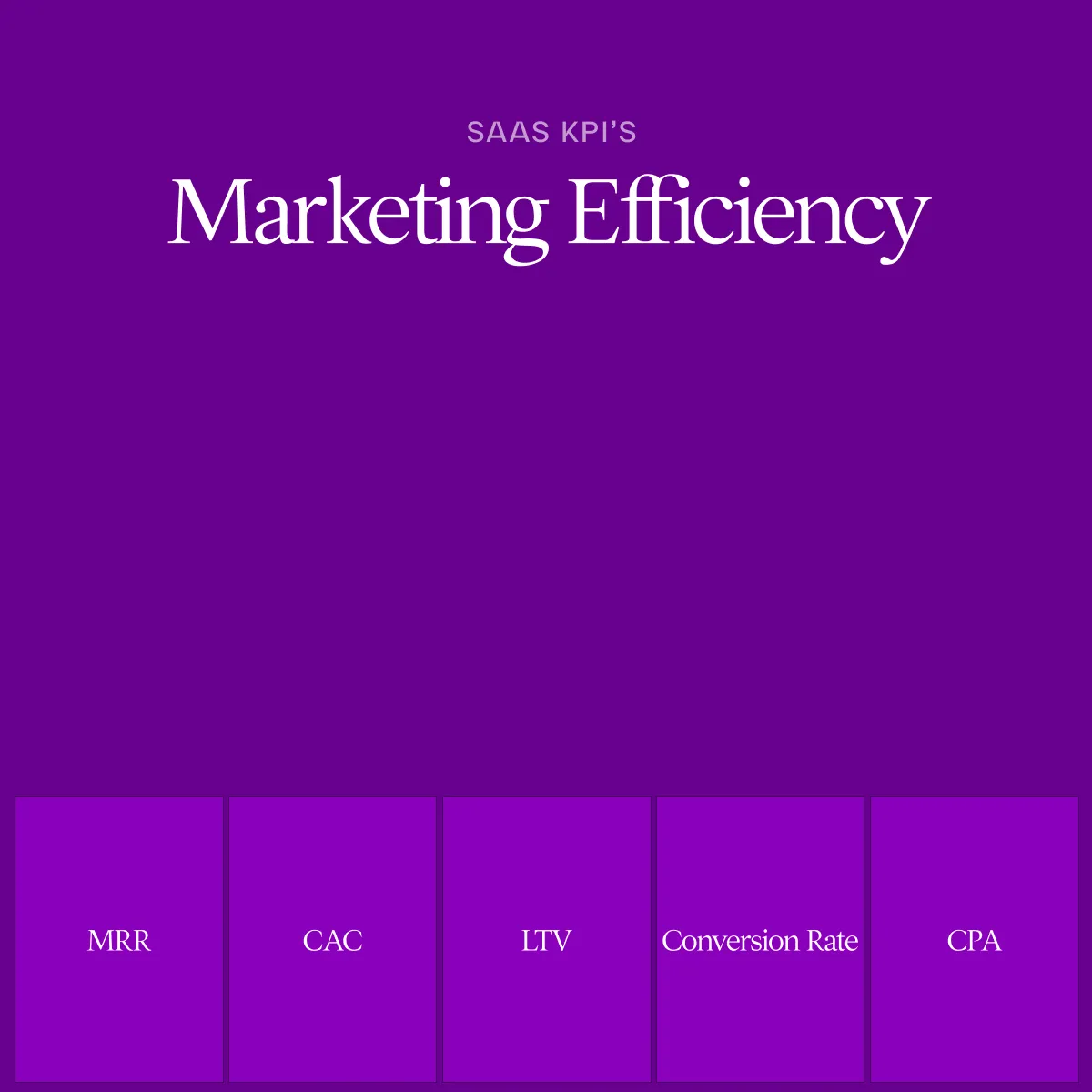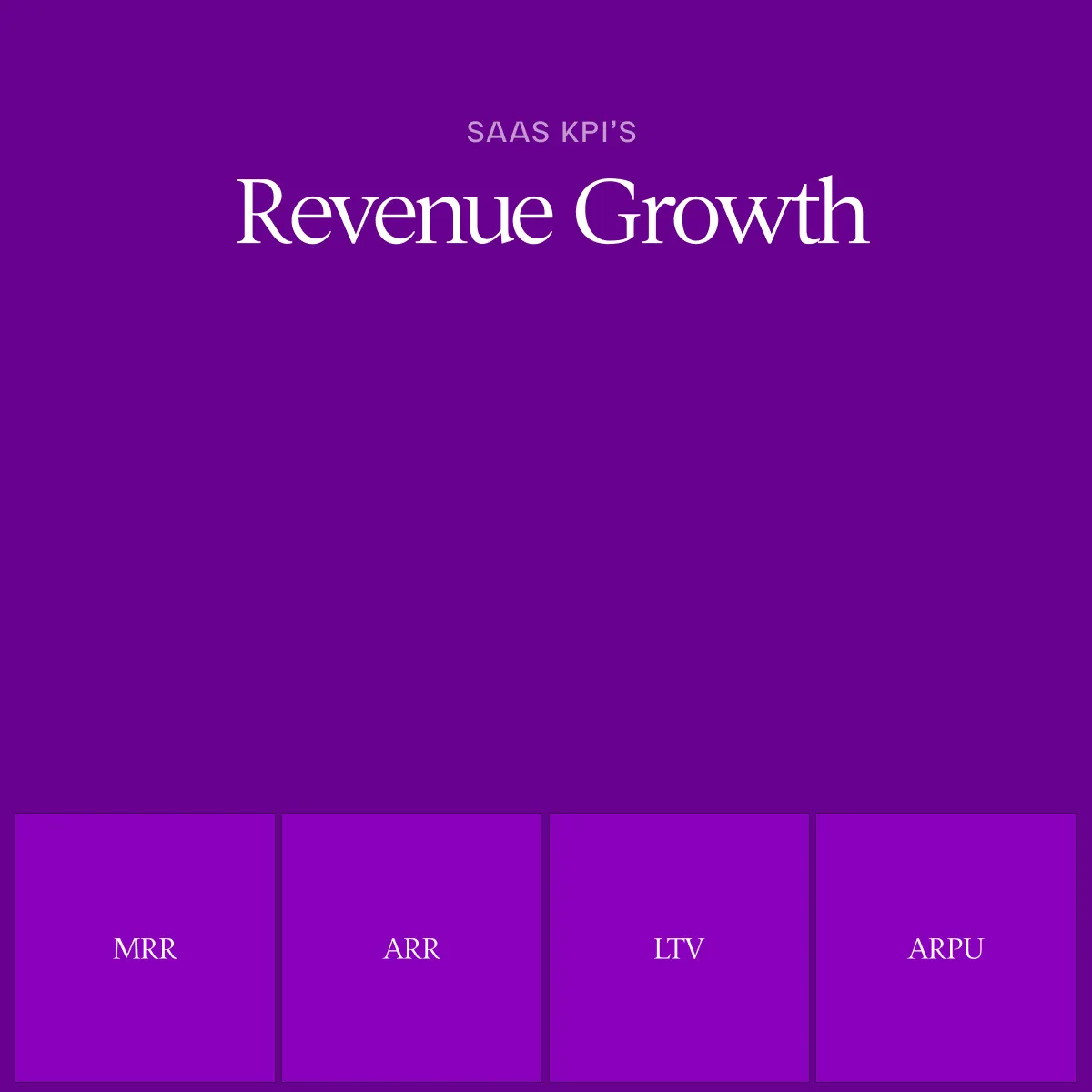SaaS KPI's – A guide to SaaS founders of the core KPI's to track
If you’re a Software as a Service entrepreneur, or part of the team at an existing startup, then tracking key performance indicators (KPIs) is essential when it comes to measuring your progress. Keeping up-to-date with SaaS KPIs across various areas helps you identify potential opportunities for growth and areas where improvements can be made. The data garnered from any changes implemented will help inform decision making in the future — whether that’s identifying new customers, improving retention rates or increasing revenue.
Knowing which metrics are particularly important in helping founders understand how their software products are performing is key; Failing to monitor them could result in increased competition, lack of visibility into success rates and ultimately customer dissatisfaction. By understanding what they need to measure and having vital stats available throughout each stage of a product's lifecycle, businesses can improve user experience while staying profitable over time. In this blog post we will explore the important saas KPIs every founder and team needs to track for optimal results.

The 14 most important KPI's to track as a SaaS company
1. Monthly Recurring Revenue (MRR): The total amount of recurring revenue from subscription-based services for the current month.
2. Annual Recurring Revenue (ARR): The total amount of recurring revenue from subscription-based services for the current year.
3. Average Revenue per User (ARPU): The average amount of revenue generated each month by an individual customer or account.
4. Churn rate (or cancellation rate): The percentage of customers who cancel their subscription or do not renew during a given period of time.
5. Customer Acquisition Cost (CAC): The cost associated with acquiring new customers, typically broken down into marketing and sales costs such as advertising, lead generation activities and sales personnel salaries and commissions.
6. Customer Lifetime Value (LTV): The net present value of the future cash flows a customer is estimated to generate over their lifetime with the company.
7. Average User Session Length: The average length of time users are logged into your application or platform during each session.
8. Conversion Rate: The percentage of visitors to your website who become customers, expressed as a percent (e.g., 30% = 1 out of 3 visitors).
9. Retention rate (or renewal rate): The percentage of customers who keep their subscription after a given period of time, usually measured on an annual basis for SaaS companies.
10. Net Promoter Score (NPS): A measure of customer satisfaction with a product or service, gauged by asking them to rate their likelihood of recommending the company to a friend on a scale from 0 - 10.
11. Lead-to-Customer Ratio: The ratio of leads who convert into customers, expressed as a percentage (e.g., 15% = 3 out of 20 leads).
12. Cost per Acquisition (CPA): The cost associated with acquiring new customers through any marketing channel, typically expressed in terms of money spent per individual sale or lead generated.
13. Daily Active Users (DAU): The number of unique users who actively use your product or service on a given day.
14. Monthly Active Users (MAU): The total number of active users who log into the system or application on a monthly basis.
Tracking these important KPIs and SaaS metrics can help SaaS businesses in many ways; from understanding user behaviour and customer lifetime value to increasing revenue and improving user experience — not to mention that it’s also useful for evaluating team performance too. By optimizing and tracking these metrics, founders and teams can identify areas for improvement, set realistic goals and measure progress over time. And if you’re just starting out, then having an understanding of these KPIs can help you establish as well as benchmark performance and set a good foundation for your business.
By tracking the right SaaS KPIs, companies can stay competitive in their respective markets while ensuring that customers are receiving value from their products. Understanding which metrics to measure and having visibility into your data allows teams to make informed decisions about product strategy, investments

SaaS KPI's – Customer Loyalty
Every business wants to keep its customers happy and loyal. But sometimes, despite best efforts, customers end up leaving. This phenomenon is known as "churn." Understanding and tracking churn rate can provide valuable insight into the health of your business. It allows you to see where you may be losing customers and identify trends or patterns.
With this information, you can take action to address the root causes of churn and improve customer retention. By implementing strategies to reduce churn, businesses can save money on customer acquisition costs and increase revenue. So, whether you're a seasoned entrepreneur or just starting out, understanding why and how to track churn rate is a critical element of your business strategy.

SaaS KPI's – Marketing Efficiency
Acquiring customers is crucial for a company's success. However, it's equally important to analyze the cost of customer acquisition, also known as User Acquisition Cost (CAC). CAC helps businesses understand how much they need to invest in acquiring a new customer, including marketing, advertising, and sales expenses.
But, the story doesn't end here. It is equally important to analyze the value of acquiring a customer over the long term, known as Lifetime Value (LTV). LTV helps businesses understand the revenue they can generate from a customer over the course of their relationship. By analyzing both these metrics together, businesses can make informed decisions about their marketing strategies, sales tactics, and overall growth plans.

SaaS KPI's – Revenue Growth
As a SaaS company, measuring your revenue growth is crucial to understanding the health and success of your business. Two key metrics to focus on are Monthly Recurring Revenue (MRR) and Average Revenue per User (ARPU). MRR is the measurement of your predictable, recurring revenue on a monthly basis, while ARPU represents the average amount of revenue generated per user. By paying attention to both metrics, you can identify trends and patterns in your revenue growth and make data-driven decisions to optimize your business. It's important to regularly track MRR and ARPU to ensure your SaaS company is achieving sustainable growth and meeting the needs of your customers.

SaaS KPI's – Onboarding Success
Are you noticing low customer activation rates for your business? It's important to assess the success of your user onboarding process. User onboarding refers to the steps a user takes to learn how to use a product or service. A successful onboarding process can lead to increased customer satisfaction, engagement, and ultimately activation. By analyzing your onboarding process, you can identify areas of improvement and make changes that will lead to a higher activation rate.

SaaS KPI's – User Engagement
The success of any business depends on how well it can retain its customers. That's why tracking user engagement and loyalty is critical for maintaining a high customer retention rate. By understanding what motivates customers to keep coming back, businesses can tailor their products and services to meet their needs and expectations.
Investing in customer retention also helps cut down on the cost of customer acquisition, which can be expensive. This is why tracking customer behavior, such as repeat purchases, feedback, and referral rates, is essential for identifying trends, weaknesses, and opportunities to grow. By prioritizing engagement and loyalty, businesses can build long-lasting relationships with customers that benefit both parties in the long run.
Gauging customer satisfaction and loyalty to your SaaS Business
As businesses strive to remain competitive, they must understand how customers perceive their products or services. The Net Promoter Score (NPS) is a widely used metric to measure customer satisfaction and loyalty. It gauges how likely a customer is to recommend a brand to others, on a scale from 0 to 10. Based on the score, customers are categorized as promoters, passives, or detractors, and the NPS can be calculated by subtracting the percentage of detractors from the percentage of promoters.
This metric allows companies to identify areas for improvement and tailor their strategies to increase customer loyalty, ultimately leading to greater success. By prioritizing customer satisfaction and loyalty, businesses can build a strong brand reputation and set themselves apart in a crowded market.
Common questions on SaaS KPI's
What is a SaaS KPI?

A SaaS KPI (Key Performance Indicator) is a metric used to measure the performance of a software-as-a-service business. These KPIs can provide valuable insights into the success of your business, helping you identify areas for improvement and set realistic goals. Popular SaaS KPIs include churn rate, user acquisition cost, monthly recurring revenue, average revenue per user, and net promoter score.
By understanding how these metrics are affecting your business, you can take action to optimize your operations and ensure long-term success. Analyzing trends in these KPIs will help you understand how well your products and services are performing and track progress over time.
What are some common SaaS KPIs?

Common SaaS KPIs include churn rate, user acquisition cost, monthly recurring revenue (MRR), average revenue per user (ARPU), and net promoter score (NPS).
– Churn rate helps businesses measure how many customers are leaving their service on a monthly basis.
– User acquisition cost measures the amount of money needed to acquire a new customer.
– Monthly recurring revenue tracks predictable, recurring revenue on a monthly basis.
– Average revenue per user reflects the average amount of revenue generated per user.
–NPS gauges how likely customers are to recommend a business to others.
How do I choose the right SaaS KPIs for my business?

Choosing the right SaaS KPIs for your business is an important step in tracking and measuring performance. Consider which metrics will be most beneficial to your goals and objectives, as well as the resources you have available.
Start with a few basic KPIs that are easy to track, such as churn rate and user acquisition cost. As you become more comfortable with these metrics, add more complex ones like MRR and ARPU. Finally, use NPS to assess customer satisfaction levels and loyalty.
How do I track my SaaS KPIs?

Once you’ve identified which KPIs to focus on, it’s time to start tracking them. There are a variety of tools available to help businesses track their SaaS KPIs, such as data visualization software and analytics platforms. Such tools can provide valuable insights into customer behavior and performance trends over time. Additionally, most analytics platforms allow users to set up automated alerts that will notify them whenever their metrics hit a certain threshold or there is an unexpected change in the data. By taking advantage of these useful tools, businesses can ensure they have access to real-time performance data and make informed decisions for growth.
At ArK – We've developed AIM which can track the core metrics you as a SaaS business need to track and monitor.
How do I improve my SaaS KPIs?

Once you’ve mastered the art of tracking your SaaS KPIs, it’s time to start improving them. Improving your KPIs starts with understanding why they are not performing well. Common factors for low KPI performance include an ineffective user onboarding process, poor customer engagement and loyalty, or unsatisfactory customer service. Once you’ve identified the root cause of any issues, take action to resolve them as quickly as possible.
Invest in processes that will improve user experience, such as refining your user onboarding process or personalizing customer outreach efforts. Additionally, use analytics tools to identify trends and opportunities that can help boost performance. By taking a proactive approach to optimizing your KPIs, you can ensure long-term success for your SaaS business.
How often should I review my SaaS KPIs?

To keep your business on the right track and ensure long-term success, it’s important to review your SaaS KPIs on a regular basis. How often you review your KPIs will vary based on the goals you’ve set for your business.
If you are looking to increase customer engagement or loyalty, you might want to review these metrics every week. However, if you are focusing more on user acquisition cost and monthly recurring revenue, reviewing these metrics once a month is likely sufficient. Once you have established an optimal schedule for reviewing your KPIs, stick to it so that you can make continuous progress towards achieving your goals.
What are some red flags that my SaaS KPIs may be indicating?

One of the most important aspects of tracking SaaS KPIs is knowing when to take action. Monitoring your KPIs regularly will allow you to identify any changes or patterns that could indicate potential issues.
Some red flags include an increase in customer churn, a decrease in MRR growth, low user engagement levels, or unprofitable customer acquisition costs. If you notice any of these warning signs, take immediate action to address the issue and minimize further damage.